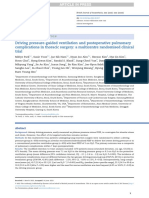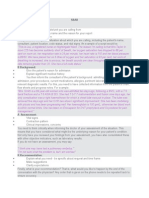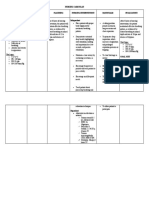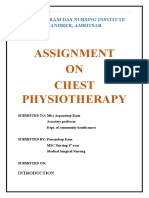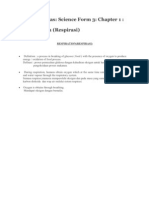Intraoperative Protective Mechanical Ventilation Fact or Fiction
Intraoperative Protective Mechanical Ventilation Fact or Fiction
Uploaded by
ema moralesCopyright:
Available Formats
Intraoperative Protective Mechanical Ventilation Fact or Fiction
Intraoperative Protective Mechanical Ventilation Fact or Fiction
Uploaded by
ema moralesOriginal Title
Copyright
Available Formats
Share this document
Did you find this document useful?
Is this content inappropriate?
Copyright:
Available Formats
Intraoperative Protective Mechanical Ventilation Fact or Fiction
Intraoperative Protective Mechanical Ventilation Fact or Fiction
Uploaded by
ema moralesCopyright:
Available Formats
Editorial
Intraoperative Protective Mechanical Ventilation: Fact or
Fiction?
Guido Musch, M.D., M.B.A., Marcos F. Vidal Melo, M.D., Ph.D.
P ositive pressure ventilation lung injury.The results instead show
Downloaded from http://pubs.asahq.org/anesthesiology/article-pdf/137/4/381/676103/20221000.0-00007.pdf by Vastra Gotalandsregionen user on 09 November 2022
gained widespread clinical no meaningful clinical or statistical
acceptance during the Danish polio difference among the four studied
epidemic of 1952,1 when it dra- groups in oxygenation within the
matically reduced the mortality of first postoperative hour, oxygen-
respiratory failure, and it has saved ation later on the ward, frequency of
countless lives in ensuing years by postoperative pulmonary complica-
enabling modern critical care and tions, or duration of hospitalization.
the safe practice of surgery under It is important to note that the
general anesthesia. Nonetheless, authors did not use excessively
evidence emerged in the 1970s high or low tidal volumes4,5 and
that positive pressure ventilation PEEP, but instead values consid-
can itself cause lung injury.2 Since ered acceptable in current clinical
then, two fundamental facts have practice.4–6 Accordingly, two main
been established. First, large tidal inferences can be drawn. First, in a
lung excursions are detrimental if cohort of patients with a low preva-
they lead to end-inspiratory overd- “When is protective intraopera- lence of lung disease and borderline
istension and/or cyclical alveolar or obesity undergoing nonabdominal
bronchiolar derecruitment–recruit- tive ventilation most beneficial?” surgery of moderate duration (about
ment between breaths. Second, the lungs of patients during 3.5 h) and without major physiologic impact (e.g., blood loss),
general anesthesia or with acute respiratory distress syndrome low tidal volumes as well as higher acceptable tidal volumes
are functionally smaller: functional residual capacity is reduced (10 ml/kg)4,5 with higher PEEP were well tolerated. It is inter-
because some of the airspaces become atelectatic, consolidated, esting that a tidal volume of 6 ml/kg did not result in lower
or flooded with edema. A corollary of these facts has been the oxygenation even at the lower PEEP, given that atelectasis is
quest to restore the relationship between tidal volume and usually considered the main downside of low tidal volume.
functional residual capacity either by decreasing the former or These results suggest that relatively healthy lungs in the stud-
increasing the latter. This concept represents the physiologic ied conditions can withstand a few hours of low tidal volume
underpinning of all “protective” ventilation strategies. ventilation during nonabdominal surgery without developing
Such framework is helpful to analyze the study by Turan significant atelectasis even at low PEEP. Higher PEEP and tidal
and colleagues3 in this issue of Anesthesiology. In this large volume did not seem to compromise postoperative lung func-
factorial crossover cluster trial, adults undergoing orthopedic tion either. Second, these results release the cognitive anchor
surgery during general anesthesia (approximately 50% also to a single optimal PEEP or tidal volume, at least in this patient
with regional block and slightly more than 50% undergoing population, and instead portray a range of equally acceptable
arthroplasty) were allocated to two levels of tidal volume (6 and values, consistent with a range—not merely a point—of max-
10 ml/kg of predicted body weight) and of positive end-ex- imal compliance in the pressure–volume curve of a healthy
piratory pressure (PEEP, 5 and 8 cm H2O). Presumably, ven- lung. This message is important because it argues against the
tilation with lower tidal volume and higher PEEP could lead transposition without qualification of inferences and values
to better postoperative oxygenation and lower incidence of derived from critical care studies to the operating room.
respiratory complications, because such a strategy would limit So, is intraoperative protective ventilation all fic-
both end-inspiratory overdistension and end-expiratory dere- tion? Substantive observational evidence has identified
cruitment, the two biophysical triggers of ventilator-induced tidal volume as a risk factor for postoperative pulmonary
Image: A. Johnson, Vivo Visuals Studio.
This editorial accompanies the article on p. 406. This article has a related Infographic on p. A19. This article has an audio podcast.
Accepted for publication August 19, 2022.
Guido Musch, M.D., M.B.A.; Department of Anesthesiology and Perioperative Medicine, UMass Chan Medical School, Worcester, Massachusetts.
Marcos F. Vidal Melo, M.D., Ph.D.; Department of Anesthesiology, Columbia University Irving Medical Center, New York, New York.
Copyright © 2022, the American Society of Anesthesiologists. All Rights Reserved. Anesthesiology 2022; 137:381–3. DOI: 10.1097/ALN.0000000000004366
ANESTHESIOLOGY, V 137 • NO 4 October 2022 381
Copyright © 2022, the American Society of Anesthesiologists. All Rights Reserved. Unauthorized reproduction of this article is prohibited.
<zdoi;. DOI: 10.1097/ALN.0000000000004366>
Editorial
complications after general anesthesia.7,8 These studies indi- they did not necessarily provide the best or single setting of
cated that “protective” ventilation (generally defined as the variable of interest to achieve that effect.
lower tidal volume plus PEEP and/or recruitment maneu- The hemodynamic impact of mechanical ventilation is fre-
vers) may reduce such complications4,8 that are associated quently a concern.A clinically meaningful finding by Turan and
with increased mortality, intensive care unit admission, and colleagues3 in this regard was the similar intraoperative use of
length of stay.7 The Intraoperative Protective Ventilation vasopressors and incidence of hypotension in all combinations
(IMPROVE) trial confirmed a marked beneficial effect of of PEEP and tidal volume. This finding reinforces the con-
protective ventilation on major abdominal surgery.6 cept that the mild-to-moderate range of ventilatory settings
Yet, as with Turan’s trial, several trials on protective venti- explored does not usually result in major hemodynamic effects.
Downloaded from http://pubs.asahq.org/anesthesiology/article-pdf/137/4/381/676103/20221000.0-00007.pdf by Vastra Gotalandsregionen user on 09 November 2022
lation did not demonstrate a difference between groups.5,9,10 The study opens several questions. Many patients were
What could explain these inconsistencies, and when is pro- excluded by anesthesiologists, or due to comorbidities, insta-
tective intraoperative ventilation most beneficial? It has been bility, or other reasons. Such subset of potentially higher-risk
increasingly recognized that the ratio of tidal volume to patients could represent those patients who would most benefit
end-expiratory lung volume, proportional to the driving pres- from specific ventilatory interventions. Although the primary
sure and a surrogate for lung strain, is the biophysical mediator outcome of Spo2/Fio2 in the first hour is a sensitive marker of
of the effects of tidal volume and PEEP on ventilator-induced oxygenation impairment, it could be affected predominantly
lung injury.4 In fact, the potential of different tidal volumes to by factors other than ventilatory settings.The absence of differ-
reduce postoperative pulmonary complications depends on the ences in the ward reinforces that any influence of intraoperative
patient’s respiratory compliance.11 This physiologic individuality settings on postoperative oxygenation was unlikely. Also, even if
may be a reason for discrepancies. Patient population is another there was an intraoperative effect of the interventions, this could
factor. The IMPROVE trial targeted a high-risk population be lost at extubation, without subsequent benefit. Finally, the
for pulmonary complications6 (major open abdominal surgery, reported rate of pulmonary complications was quite low, imply-
pre-existent respiratory risk factors), whereas Turan and col- ing a low-risk group and the potential risk for false negatives,
leagues studied a population at lower risk3 based on the Assess given that the occurrence of those complications derived from
Respiratory Risk in Surgical Patients in Catalonia risk score.12 registry and billing data not from prospective collection.
There is evidence that pulmonary outcomes are less likely to Such limitations will deserve future exploration to advance
depend on PEEP in nonabdominal/noncardiothoracic surgery, this relevant area. For now, Turan and colleagues provide evi-
e.g., neurologic versus abdominal surgery.13 This also implies dence that mild-to-moderate differences in key ventilator
that Turan’s results should not be extrapolated to abdominal or settings—tidal volume and PEEP—within currently accepted
cardiothoracic surgery, when additional injury mechanisms are ranges do not result in substantial differential effects on post-
present and, consequently, the effects of different ventilatory set- operative oxygenation and other pulmonary outcomes during
tings could be more evident.13 Time may also be an important orthopedic surgery. Mechanical ventilation in the operating
variable. Normal lungs show only limited inflammation after room requires its own specific set of knowledge, with ranges
2 h of ventilation even at high driving pressures.14 Sixteen to different from those of patients with acute respiratory distress
24 h were necessary for a significant pulmonary inflammatory syndrome in intensive care units. Protective ventilation is not
response and mechanical deterioration to develop in experi- defined by single arbitrary numbers, but by ranges of venti-
ments applying clinical tidal volumes (6 to 8 ml/kg) in initially latory settings that likely differ in distinct conditions and in
uninjured lungs.15–17 Finally, the separation between ventilator relation to patient-specific physiopathologic features.
settings is relevant.The IMPROVE trial acted on multiple vari- Research Support
ables (tidal volume, PEEP, recruitment maneuvers) setting them
apart enough (tidal volumes of 6 to 8 ml/kg with PEEP = 6 to Dr. Vidal Melo was supported by National Institutes of
8 cm H2O versus 10 to 12 ml/kg with PEEP = 0 cm H20) that, Health-National Heart, Lung, and Blood Institute (Bethesda,
presumably, the effect could be detected in contrast to current Maryland) grants UH3HL140177 and R01HL121228.
practice used by Turan and colleagues.3
If there is a range of equally acceptable values for ventila- Competing Interests
tory settings, it may be hard to show an effect, especially when The authors declare no competing interests.
clinical practice has already converged toward such a range.
Turan and colleagues studied a large population and observed Correspondence
a smaller SD for the primary outcome than that initially pre-
sumed, which ultimately yielded a high power to detect the Address correspondence to Dr. Vidal Melo: mv2869@
predefined mean effect.The 97.5% CIs for the effect estimates cumc.colmbia.edu
were a time-weighted average Spo2/Fio2 of –0.4 to 7.3% for
tidal volume and –4.0 to 3.6% for PEEP, numbers that con- References
vincingly demonstrate comparable postoperative oxygenation
in the studied groups. These results also imply that, although 1. Ibsen B: The anaesthetist’s viewpoint on the treatment
previous clinical studies documented the presence of an effect, of respiratory complications in poliomyelitis during
382 Anesthesiology 2022; 137:381–3 G. Musch and M. F. Vidal Melo
Copyright © 2022, the American Society of Anesthesiologists. All Rights Reserved. Unauthorized reproduction of this article is prohibited.
Editorial
the epidemic in Copenhagen, 1952. Proc R Soc Med Hemmes SN, Gama de Abreu M, Pelosi P, Schultz
1954; 47:72–4 MJ: High versus low positive end-expiratory pressure
2. Webb HH,Tierney DF: Experimental pulmonary edema during general anaesthesia for open abdominal surgery
due to intermittent positive pressure ventilation with (PROVHILO trial): a multicentre randomised con-
high inflation pressures. Protection by positive end-expi- trolled trial. Lancet 2014; 384:495–503
ratory pressure. Am Rev Respir Dis 1974; 110:556–65 10. Lagier D, Fischer F, Fornier W, Huynh TM, Cholley
3. Turan A, Esa WAS, Rivas E,Wang J, Bakal O, Stamper S, B, Guinard B, Heger B, Quintana G, Villacorta J,
Farag E, Maheswari K, Mao G, Ruetzler K, Sessler DI; Gaillat F, Gomert R, Degirmenci S, Colson P, Lalande
Ventilation-PEEP Trial Group: Tidal volume and posi- M, Benkouiten S, Minh TH, Pozzi M, Collart F,
Downloaded from http://pubs.asahq.org/anesthesiology/article-pdf/137/4/381/676103/20221000.0-00007.pdf by Vastra Gotalandsregionen user on 09 November 2022
tive end-expiratory pressure and postoperative hypox- Latremouille C,Vidal Melo MF,Velly LJ, Jaber S, Fellahi
emia during general anesthesia:A single-center multiple JL, Baumstarck K, Guidon C; PROVECS Study Group:
crossover factorial cluster trial. Anesthesiology 2022; Effect of open-lung vs conventional perioperative ven-
137:406–17 tilation strategies on postoperative pulmonary compli-
4. Ladha K, Vidal Melo MF, McLean DJ, Wanderer JP, cations after on-pump cardiac surgery: the PROVECS
Grabitz SD, Kurth T, Eikermann M: Intraoperative pro- randomized clinical trial. Intensive Care Med 2019;
tective mechanical ventilation and risk of postoperative 45:1401–12
respiratory complications: hospital based registry study. 11. Suleiman A, Costa E, Santer P,Tartler TM,Wachtendorf
BMJ 2015; 351:h3646 LJ, Teja B, Chen G, Baedorf-Kassis E, Nagrebetsky
5. Karalapillai D, Weinberg L, Peyton P, Ellard L, Hu R, A, Vidal Melo MF, Eikermann M, Schaefer MS:
Pearce B, Tan CO, Story D, O’Donnell M, Hamilton Association between intraoperative tidal volume and
P, Oughton C, Galtieri J, Wilson A, Serpa Neto A, postoperative respiratory complications is dependent
Eastwood G, Bellomo R, Jones DA: Effect of intraop- on respiratory elastance: A retrospective, multicentre
erative low tidal volume vs conventional tidal volume cohort study. Br J Anaesth 2022; 129:263–72
on postoperative pulmonary complications in patients 12. Canet J, Gallart L, Gomar C, Paluzie G,Vallès J, Castillo
undergoing major surgery: A randomized clinical trial. J, Sabaté S, Mazo V, Briones Z, Sanchis J; ARISCAT
JAMA 2020; 324:848–58 Group: Prediction of postoperative pulmonary com-
6. Futier E, Constantin JM, Paugam-Burtz C, Pascal J, Eurin plications in a population-based surgical cohort.
M, Neuschwander A, Marret E, Beaussier M, Gutton C, Anesthesiology 2010; 113:1338–50
Lefrant JY, Allaouchiche B,Verzilli D, Leone M, De Jong 13. de Jong MAC, Ladha KS, Vidal Melo MF, Staehr-Rye
A, Bazin JE, Pereira B, Jaber S; IMPROVE Study Group: AK, Bittner EA, Kurth T, Eikermann M: Differential
A trial of intraoperative low-tidal-volume ventilation in effects of intraoperative positive end-expiratory
abdominal surgery. N Engl J Med 2013; 369:428–37 pressure (PEEP) on respiratory outcome in major
7. Fernandez-Bustamante A, Frendl G, Sprung J, Kor DJ, abdominal surgery versus craniotomy. Ann Surg 2016;
Subramaniam B, Martinez Ruiz R, Lee JW, Henderson 264:362–9
WG, Moss A, Mehdiratta N, Colwell MM, Bartels K, 14. Costa EL, Musch G,Winkler T, Schroeder T, Harris RS,
Kolodzie K, Giquel J, Vidal Melo MF: Postoperative Jones HA, Venegas JG, Vidal Melo MF: Mild endotox-
pulmonary complications, early mortality, and hospi- emia during mechanical ventilation produces spatially
tal stay following noncardiothoracic surgery: A multi- heterogeneous pulmonary neutrophilic inflammation
center study by the Perioperative Research Network in sheep. Anesthesiology 2010; 112:658–69
Investigators. JAMA Surg 2017; 152:157–66 15. Tucci MR, Costa EL,Wellman TJ, Musch G,Winkler T,
8. Serpa Neto A, Hemmes SN, Barbas CS, Beiderlinden Harris RS,Venegas JG, Amato MB, Melo MF: Regional
M, Biehl M, Binnekade JM, Canet J, Fernandez- lung derecruitment and inflammation during 16 hours
Bustamante A, Futier E, Gajic O, Hedenstierna G, of mechanical ventilation in supine healthy sheep.
Hollmann MW, Jaber S, Kozian A, Licker M, Lin WQ, Anesthesiology 2013; 119:156–65
Maslow AD, Memtsoudis SG, Reis Miranda D, Moine P, 16. Szabari MV, Takahashi K, Feng Y, Locascio JJ, Chao
Ng T, Paparella D, Putensen C, Ranieri M, Scavonetto F, W, Carter EA, Vidal Melo MF, Musch G: Relation
Schilling T, Schmid W, Selmo G, Severgnini P, Sprung J, between respiratory mechanics, inflammation, and
Sundar S, Talmor D, Treschan T, Unzueta C, Weingarten survival in experimental mechanical ventilation. Am J
TN, Wolthuis EK, Wrigge H, Gama de Abreu M, Respir Cell Mol Biol 2019; 60:179–88
Pelosi P, Schultz MJ; PROVE Network Investigators: 17. Motta-Ribeiro GC, Hashimoto S, Winkler T, Baron
Protective versus conventional ventilation for surgery: A RM, Grogg K, Paula LFSC, Santos A, Zeng C, Hibbert
systematic review and individual patient data meta-anal- K, Harris RS, Bajwa E, Melo MFV: Deterioration of
ysis. Anesthesiology 2015; 123:66–78 regional lung strain and inflammation during early lung
9. PROVE Network Investigators for the Clinical Trial injury. Am J Respir Crit Care Med 2018; 198:891–902.
Network of the European Society of Anaesthesiology, 10.1164/rccm.201710-2038OC
G. Musch and M. F. Vidal Melo Anesthesiology 2022; 137:381–3 383
Copyright © 2022, the American Society of Anesthesiologists. All Rights Reserved. Unauthorized reproduction of this article is prohibited.
You might also like
- ATLS Practice Test 3 Answers & ExplanationsDocument10 pagesATLS Practice Test 3 Answers & ExplanationsCarl Sars67% (3)
- Intraoperative Protective Mechanical VentilationDocument3 pagesIntraoperative Protective Mechanical VentilationNeumo CovidNo ratings yet
- Ventilation During Lung Resection and Critical Care ComparativeDocument11 pagesVentilation During Lung Resection and Critical Care Comparativeema moralesNo ratings yet
- Intraoperative Mechanical Ventilation & Postop Complications 2021Document17 pagesIntraoperative Mechanical Ventilation & Postop Complications 2021Angy KarakostaNo ratings yet
- Current Concepts of Protective Ventilation During GA - 2015Document8 pagesCurrent Concepts of Protective Ventilation During GA - 2015Angy KarakostaNo ratings yet
- Lungprotective Ventilation Initiated in the Emergency Department LOVED a Study Protocol for a Quasiexperimental Beforeafter Trial Aimed at Reducing Pulmonary Complications 2016 BMJ Publishing Group SubscriptionDocument8 pagesLungprotective Ventilation Initiated in the Emergency Department LOVED a Study Protocol for a Quasiexperimental Beforeafter Trial Aimed at Reducing Pulmonary Complications 2016 BMJ Publishing Group SubscriptionevyNo ratings yet
- Volume Targeted VentilationDocument28 pagesVolume Targeted VentilationhosnameskarNo ratings yet
- Driving Pressure Study OLVDocument13 pagesDriving Pressure Study OLVlucasNo ratings yet
- Advances in The Support of Respiratory FailureDocument7 pagesAdvances in The Support of Respiratory FailureFabio RepettoNo ratings yet
- Severgnini 2013Document15 pagesSevergnini 2013moraeunwprqphslndfNo ratings yet
- The Physiologically Difficult Airway: Eview RticleDocument9 pagesThe Physiologically Difficult Airway: Eview RticleEdson Llerena SalvoNo ratings yet
- 20201000.0-00007Document3 pages20201000.0-00007Laís R. TeixeiraNo ratings yet
- Jurnal 5Document7 pagesJurnal 5nskhldNo ratings yet
- Effect of Protective Ventilation On Postoperative Pulmonary Complications in Patients Undergoing General AnaesthesiaDocument8 pagesEffect of Protective Ventilation On Postoperative Pulmonary Complications in Patients Undergoing General AnaesthesiahubertandharrietNo ratings yet
- Fessler - 2010Document12 pagesFessler - 2010Cindy KarmilaNo ratings yet
- Close Lung 2018Document8 pagesClose Lung 2018Sergio CastellanosNo ratings yet
- carbon-dioxide-dialysis-will-save-the-lung.-critical-care-2010-vol.-38-n.-10-pesentiDocument6 pagescarbon-dioxide-dialysis-will-save-the-lung.-critical-care-2010-vol.-38-n.-10-pesentiKevin YaoNo ratings yet
- 1 GRDocument3 pages1 GRFabiola Novita SariNo ratings yet
- Modes and Strategies For Providing Conventional Mechanical Ventilation in NeonatesDocument6 pagesModes and Strategies For Providing Conventional Mechanical Ventilation in Neonatesbig023296No ratings yet
- Hfo 3Document8 pagesHfo 3markus_danusantosoNo ratings yet
- JPM 13 00358Document7 pagesJPM 13 00358Barbara SouzaNo ratings yet
- A Review of Intraoperative Protective Ventilation: Review Article Open AccessDocument9 pagesA Review of Intraoperative Protective Ventilation: Review Article Open AccessLeiniker NavarroNo ratings yet
- Intraop MV and PPC After CC Anest 2019Document17 pagesIntraop MV and PPC After CC Anest 2019Jenny ACNo ratings yet
- PEEP Guided by Electrical Impedance Tomography During One-Lung Ventilation in Elderly Patients Undergoing Thoracoscopic SurgeryDocument12 pagesPEEP Guided by Electrical Impedance Tomography During One-Lung Ventilation in Elderly Patients Undergoing Thoracoscopic SurgeryhubertandharrietNo ratings yet
- Tidal Volume in Patients With Normal Lungs During General AnesthesiaDocument9 pagesTidal Volume in Patients With Normal Lungs During General Anesthesiariri fitrisariNo ratings yet
- Mathis Et. Al. Intraoperative MV & PPCDocument17 pagesMathis Et. Al. Intraoperative MV & PPCJun HungNo ratings yet
- Lung and Diaphragm Protective Ventilation Guided by The EsophagealDocument3 pagesLung and Diaphragm Protective Ventilation Guided by The Esophagealema moralesNo ratings yet
- Lagier2022 Atelectasia en AnestesiologiaDocument31 pagesLagier2022 Atelectasia en AnestesiologiaNicolas SuarezNo ratings yet
- WWW Minervamedica It@r02y2016n01a0058Document11 pagesWWW Minervamedica It@r02y2016n01a0058Gonzalo Venegas RojasNo ratings yet
- Lung Blast InjuryDocument10 pagesLung Blast InjuryHany ElbarougyNo ratings yet
- Optimizing Mechanical Ventilation, Lung Imaging and Intrapulmonary Drug Delivery in OR - ICU - 2019Document25 pagesOptimizing Mechanical Ventilation, Lung Imaging and Intrapulmonary Drug Delivery in OR - ICU - 2019Angy KarakostaNo ratings yet
- Pulmonary Atelectasis: A Pathogenic Perioperative EntityDocument17 pagesPulmonary Atelectasis: A Pathogenic Perioperative EntityDaniel Martinez HernándezNo ratings yet
- NAVA and PAV For Lung and Diaphragm ProtectionDocument6 pagesNAVA and PAV For Lung and Diaphragm ProtectionDaniel Oscar Pintos ChiesaNo ratings yet
- Newer Modes of Ventilation2Document9 pagesNewer Modes of Ventilation2Saradha PellatiNo ratings yet
- Less Is More in Mechanical Ventilation, LGattinoniDocument3 pagesLess Is More in Mechanical Ventilation, LGattinoniErnesto De HaroNo ratings yet
- Lagier 2022Document31 pagesLagier 2022Carlos Daniel AliagaNo ratings yet
- Hypercapnia and Acidosis in Sepsis: A Double-Edged Sword?Document11 pagesHypercapnia and Acidosis in Sepsis: A Double-Edged Sword?martinivanNo ratings yet
- Modes of Mechanical Ventilation For The Operating Room BestPracResAnest 2015 PDFDocument15 pagesModes of Mechanical Ventilation For The Operating Room BestPracResAnest 2015 PDFRicardoNo ratings yet
- Vasques 2018Document14 pagesVasques 2018Luciana SandovalNo ratings yet
- The ABC of Weaning Failure - A Structured ApproachDocument9 pagesThe ABC of Weaning Failure - A Structured ApproachArul ShanmugamNo ratings yet
- Prévention Des P'SILIDocument15 pagesPrévention Des P'SILIBruno ValeNo ratings yet
- Rapid Sequence Induction-Intubation What Needs To Be FastDocument4 pagesRapid Sequence Induction-Intubation What Needs To Be Fastمحمد عقيليNo ratings yet
- Mechanical Ventilation To Minimize Progression of Lung Injury in Acute Respiratory FailureDocument5 pagesMechanical Ventilation To Minimize Progression of Lung Injury in Acute Respiratory FailureGenoveva Navarro SolorzaNo ratings yet
- Journal of Anesthesia & Clinical ResearchDocument8 pagesJournal of Anesthesia & Clinical ResearchAyu Aprilisa D PutriNo ratings yet
- Atelectasias en ObesosDocument6 pagesAtelectasias en ObesosHernan Dario GuerreroNo ratings yet
- Hfo 2Document9 pagesHfo 2markus_danusantosoNo ratings yet
- Intraoperative Mechanical Ventilation Strategies in Patients Undergoing One-Lung Ventilation: A Meta-AnalysisDocument12 pagesIntraoperative Mechanical Ventilation Strategies in Patients Undergoing One-Lung Ventilation: A Meta-AnalysisdrvmkamathNo ratings yet
- 2022-10# (PEERJ) RR in ECMODocument17 pages2022-10# (PEERJ) RR in ECMOjycntuNo ratings yet
- Physiology of Mechanical Ventilation Critical Care ClinicsDocument218 pagesPhysiology of Mechanical Ventilation Critical Care ClinicsQuelamiaNo ratings yet
- Prolonged Mechanical Ventilation Alters Diaphragmatic Structure and FunctionDocument17 pagesProlonged Mechanical Ventilation Alters Diaphragmatic Structure and FunctionmvmarentesNo ratings yet
- Doenças PleuraisDocument9 pagesDoenças Pleuraiselizete rodriguesNo ratings yet
- Autologous Blood Patch Pleurodesis: A Large Retrospective Multicenter Cohort StudyDocument7 pagesAutologous Blood Patch Pleurodesis: A Large Retrospective Multicenter Cohort StudySabri AbyNo ratings yet
- Jurnal 5 atelektasisDocument13 pagesJurnal 5 atelektasisWana KlkNo ratings yet
- Ventilation With A Low Tidal Volume vs. An Intermediate Tidal Volume During Pleural DecorticationDocument9 pagesVentilation With A Low Tidal Volume vs. An Intermediate Tidal Volume During Pleural DecorticationAfridatul LuailiyahNo ratings yet
- Mechanical Ventilation - Lessons From The ARDSNet TrialDocument5 pagesMechanical Ventilation - Lessons From The ARDSNet TrialRDG20202No ratings yet
- Estrategias VM en Sdra y EpocDocument17 pagesEstrategias VM en Sdra y EpocCARLOS ANDRESNo ratings yet
- Anesthessia During OesophagectomyDocument8 pagesAnesthessia During OesophagectomyAngy KarakostaNo ratings yet
- NMD Value Clinical Dossier Study LRDocument23 pagesNMD Value Clinical Dossier Study LRfarahNo ratings yet
- WeaningDocument9 pagesWeaningMonica Alejandra Estrada SorianoNo ratings yet
- Essentials in Lung TransplantationFrom EverandEssentials in Lung TransplantationAllan R. GlanvilleNo ratings yet
- Basics and modern practice of nasal high-flow therapyFrom EverandBasics and modern practice of nasal high-flow therapyRating: 5 out of 5 stars5/5 (1)
- Lung and Diaphragm Protective Ventilation Guided by The EsophagealDocument3 pagesLung and Diaphragm Protective Ventilation Guided by The Esophagealema moralesNo ratings yet
- Lung and Airway Ultrasound in Pediatric AnesthesiaDocument7 pagesLung and Airway Ultrasound in Pediatric Anesthesiaema moralesNo ratings yet
- Management of Patient-Ventilator AsynchronyDocument8 pagesManagement of Patient-Ventilator Asynchronyema moralesNo ratings yet
- Difficult or Impossible Facemask Ventilation in Children With DifficultDocument10 pagesDifficult or Impossible Facemask Ventilation in Children With Difficultema moralesNo ratings yet
- Guar Raci No 2016Document14 pagesGuar Raci No 2016ema moralesNo ratings yet
- Hampson Evans Darryl Pediatric LaryngospasmDocument5 pagesHampson Evans Darryl Pediatric Laryngospasmema moralesNo ratings yet
- A Survey of The Global Impact of COVID 19 On The Practice of PediatricDocument10 pagesA Survey of The Global Impact of COVID 19 On The Practice of Pediatricema moralesNo ratings yet
- Preoperative COVID 19 Testing at Pediatric Institutions-CurrentDocument3 pagesPreoperative COVID 19 Testing at Pediatric Institutions-Currentema moralesNo ratings yet
- Effects of Preoperative Pregabalin On Outcome of Spinal Anaesthesia For Patients Undergoing Open MyomectomyDocument8 pagesEffects of Preoperative Pregabalin On Outcome of Spinal Anaesthesia For Patients Undergoing Open Myomectomyema moralesNo ratings yet
- Cureus 0014 00000029117Document8 pagesCureus 0014 00000029117ema moralesNo ratings yet
- PregabalinaDocument5 pagesPregabalinaema moralesNo ratings yet
- Turkjmedsci 50 195Document11 pagesTurkjmedsci 50 195ema moralesNo ratings yet
- Lirk 2017Document12 pagesLirk 2017ema moralesNo ratings yet
- Anes 10 3 9Document7 pagesAnes 10 3 9ema moralesNo ratings yet
- Guyton and Hall Textbook of Medical Physiology (Guyton Physiology) - 13th Edition. ISBN 1455770051, 978-1455770052Document23 pagesGuyton and Hall Textbook of Medical Physiology (Guyton Physiology) - 13th Edition. ISBN 1455770051, 978-1455770052terrijariblgf100% (8)
- Pig DLab ReportDocument3 pagesPig DLab Reportiloveyou205No ratings yet
- Instruction: Select The Correct Answer For Each of The Following Questions. Mark Only One Answer byDocument7 pagesInstruction: Select The Correct Answer For Each of The Following Questions. Mark Only One Answer byEden Marie FranciscoNo ratings yet
- Como Optimizar La EntubaciónDocument4 pagesComo Optimizar La EntubaciónKaren Aline Gómez CruzNo ratings yet
- Respiratory Failure: PathophysiologyDocument5 pagesRespiratory Failure: PathophysiologyFaisal Reza AdiebNo ratings yet
- SDL R VS OldDocument6 pagesSDL R VS Oldsejal3vijNo ratings yet
- High Frequency Ventilation - 2021 - Clinics in PerinatologyDocument14 pagesHigh Frequency Ventilation - 2021 - Clinics in PerinatologyCamilaNo ratings yet
- Unanticipated Difficult Tracheal Intubation Algorithm UpdateDocument1 pageUnanticipated Difficult Tracheal Intubation Algorithm UpdateEyad AbdeljawadNo ratings yet
- Chest Tube: Dr. Feizal FaturahmanDocument21 pagesChest Tube: Dr. Feizal FaturahmanfaturNo ratings yet
- Davies Veterinary Specialists UnderstandingDocument3 pagesDavies Veterinary Specialists UnderstandingFelicity HumphreysNo ratings yet
- Sbar CommunicationDocument2 pagesSbar CommunicationSetina100% (1)
- Mcu AnnualDocument28 pagesMcu AnnualHanny WibowoNo ratings yet
- MSDS Sulphuric Acid PDFDocument7 pagesMSDS Sulphuric Acid PDFshaik rafi100% (2)
- 2ND SEM Q2 GENBIO 2 MODULE (Reproduction To Feedback Mechanisms)Document43 pages2ND SEM Q2 GENBIO 2 MODULE (Reproduction To Feedback Mechanisms)pixNo ratings yet
- What Is: Glukosa Oksigen Karbon Dioksida AirDocument11 pagesWhat Is: Glukosa Oksigen Karbon Dioksida Airmeshal retteryNo ratings yet
- Aquapor h300 Pi 9107502 en GBDocument8 pagesAquapor h300 Pi 9107502 en GBHaitham AlhomaideNo ratings yet
- Evs Worksheet and pt1Document14 pagesEvs Worksheet and pt1saranyakrishnakumar1988No ratings yet
- NCP 106Document8 pagesNCP 106yer tagalajNo ratings yet
- Using Nose Drops and SpraysDocument1 pageUsing Nose Drops and SpraysRajender BishtNo ratings yet
- James Ruse 2005 Biology Prelim HY & SolutionsDocument15 pagesJames Ruse 2005 Biology Prelim HY & SolutionsAnna Wong100% (1)
- 5th STD Term I Science EM - FTB - V22Document40 pages5th STD Term I Science EM - FTB - V22Dr. Naresh GohelNo ratings yet
- Pneumonia Case Study: Armed Forces of The Philippines Medical Center Medical Intensive Care UnitDocument49 pagesPneumonia Case Study: Armed Forces of The Philippines Medical Center Medical Intensive Care UnitLei Ortega100% (1)
- Investigations of Respiratory SystemDocument20 pagesInvestigations of Respiratory SystemSubhada GosaviNo ratings yet
- Nursing Care Plan Assesment Nursing Diagnosis Planning Nursing Intervention Rationale EvaluationDocument2 pagesNursing Care Plan Assesment Nursing Diagnosis Planning Nursing Intervention Rationale EvaluationNicole Anne TungolNo ratings yet
- Bubble C Pap SopDocument6 pagesBubble C Pap SopSupianto SuoiantoNo ratings yet
- Medicine OSCEDocument21 pagesMedicine OSCEAakash KsNo ratings yet
- AVIAN Respiratory SystemDocument7 pagesAVIAN Respiratory Systemtaner_soysurenNo ratings yet
- Assignment ON Chest Physiotherapy: Sri Guru Ram Das Nursing Institute Pandher, AmritsarDocument13 pagesAssignment ON Chest Physiotherapy: Sri Guru Ram Das Nursing Institute Pandher, AmritsarPawan BatthNo ratings yet
- Nota Ringkas Sains Bab 1 RespirasiDocument6 pagesNota Ringkas Sains Bab 1 RespirasiZuraina ShaharomNo ratings yet







